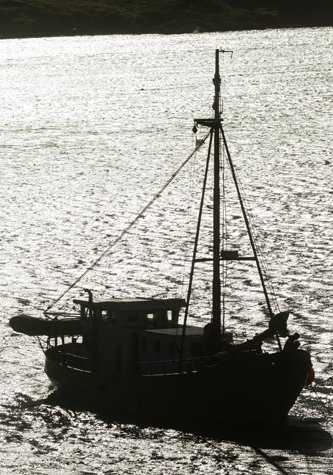The western Falklands are the wild side of this South Atlantic archipelago. Black-browed Albatross walk carefully over wide ledges of grey rock and spread the tips of their wings to catch the wind with great care, then open them wide and suddenly they are gone. They are perfect spirits of the air and the sea, again soaring above and beyond the cliffs where we stand watching them. Rockhopper penguins make their little jumps, one rock at a time, up steep gullies and stony slopes to reach their nesting sites where they squabble and call to each other, impatient to return to the ocean that is their true home. Striated Caracaras are everywhere. Riding the wind with a different style, they hover over us and drop to investigate anything left on the ground for even a moment. The small islands which are home to all of these creatures are the fringe, the edge of the archipelago - the sea is always in view, covered in whitecaps, defining the islands and opening wide to the west.
Of course, this rugged edge of the Falklands has its gentle side as well. There are quiet beaches of fine grey sand and rolling grassy hills that climb to the top of the sea cliffs. Kelp Geese, Black-crowned Night Herons and Flightless Steamer Ducks patrol the tidal pools and the kelp beds. Peale’s and Commerson’s dolphins streak through the cold, green water further out and ride the wakes of our Zodiacs as we ride ashore. And there are small communities of people making their homes here and welcoming us with friendly smiles when we visit. Friendly smiles and tables that seem about to collapse beneath the weight of cookies and cakes and tarts and buns, freshly baked for our arrival. Hot coffee and tea complete the picture and the table is soon relieved of most of its load. There’s really nothing anywhere like a Falkland Islands farm tea, the scones alone are worth coming halfway around the world.
And today we did it all under a cloudless blue sky and bright sunshine – one of the most beautiful days we’ve seen on our entire expedition. Some of us began with an early start for a long hike across Carcass Island with some excellent birdwatching along the way, while others chose to take a slower pace and concentrate on photography around the settlement. Nearly everyone finished the morning with tea and a wonderful assortment of home-baked treats at the farmhouse. During a short break for lunch the National Geographic Explorer moved around to New Island, the westernmost in the archipelago, where we went ashore for our final landing. A short hike up through fields of long grass brought us to the top of a cliff where albatross and penguins were nesting, only a few feet below the tussock grass where we sat to watch. Albatross, shags and caracaras flew by just over our heads and far below the big swells crashed onto the base of the cliff, tearing into brilliant shreds in a narrow cleft in the rocks.
Sunshine, wildlife, good food, good friends and a few final penguins. It was the perfect end to a wonderful expedition.







